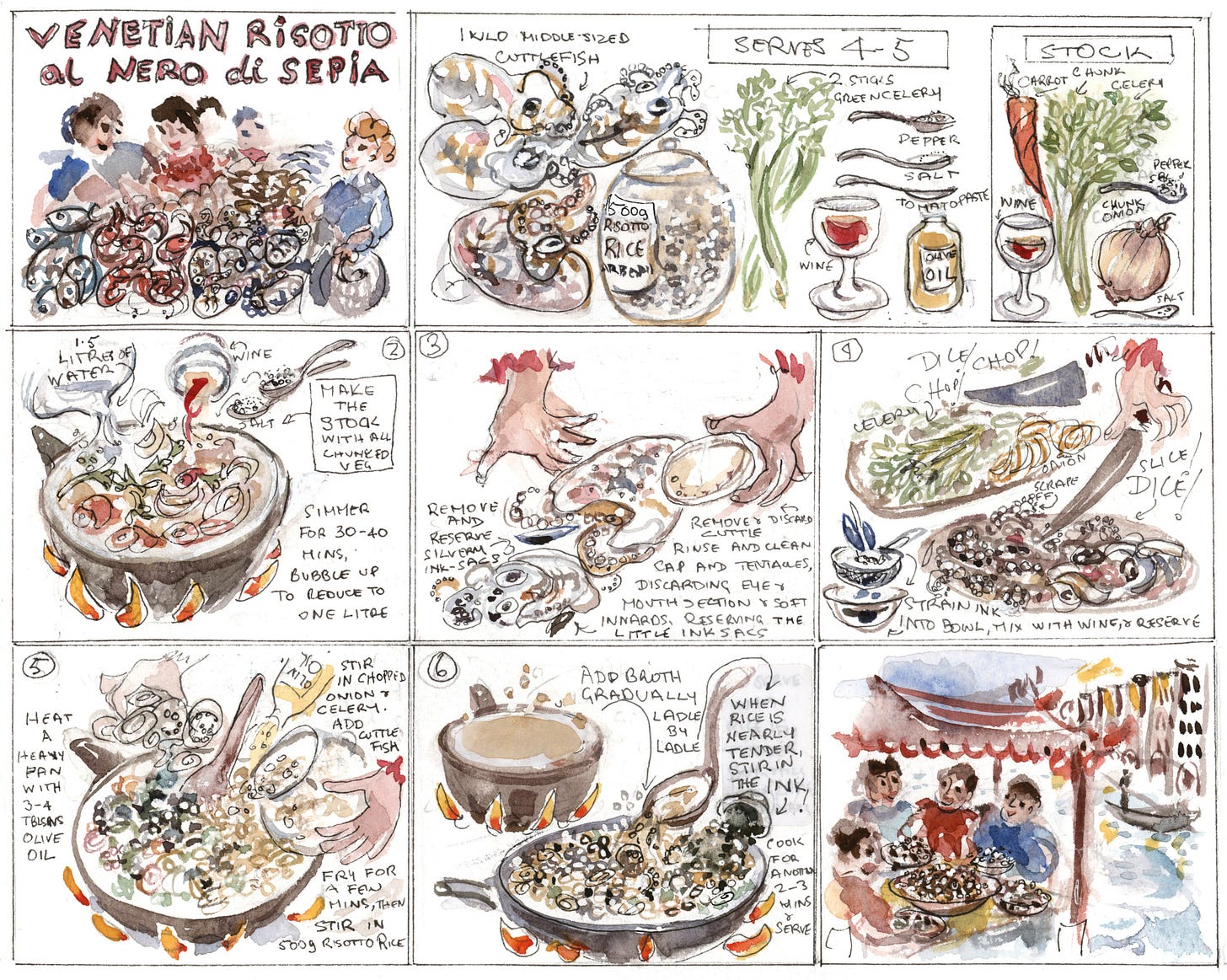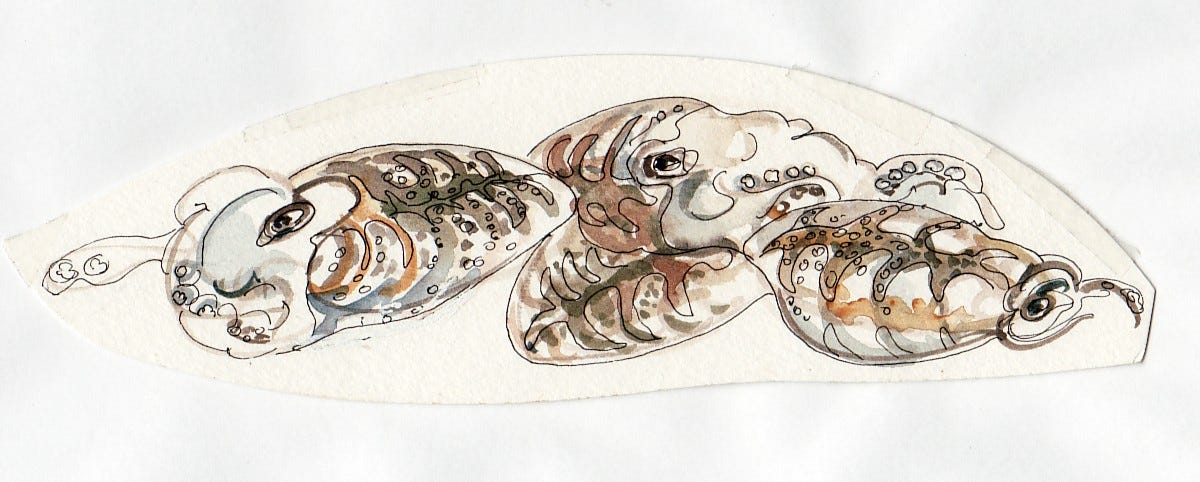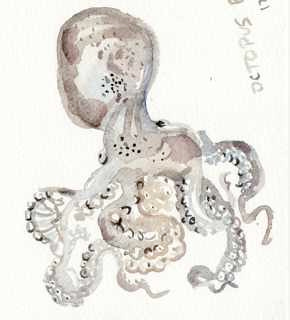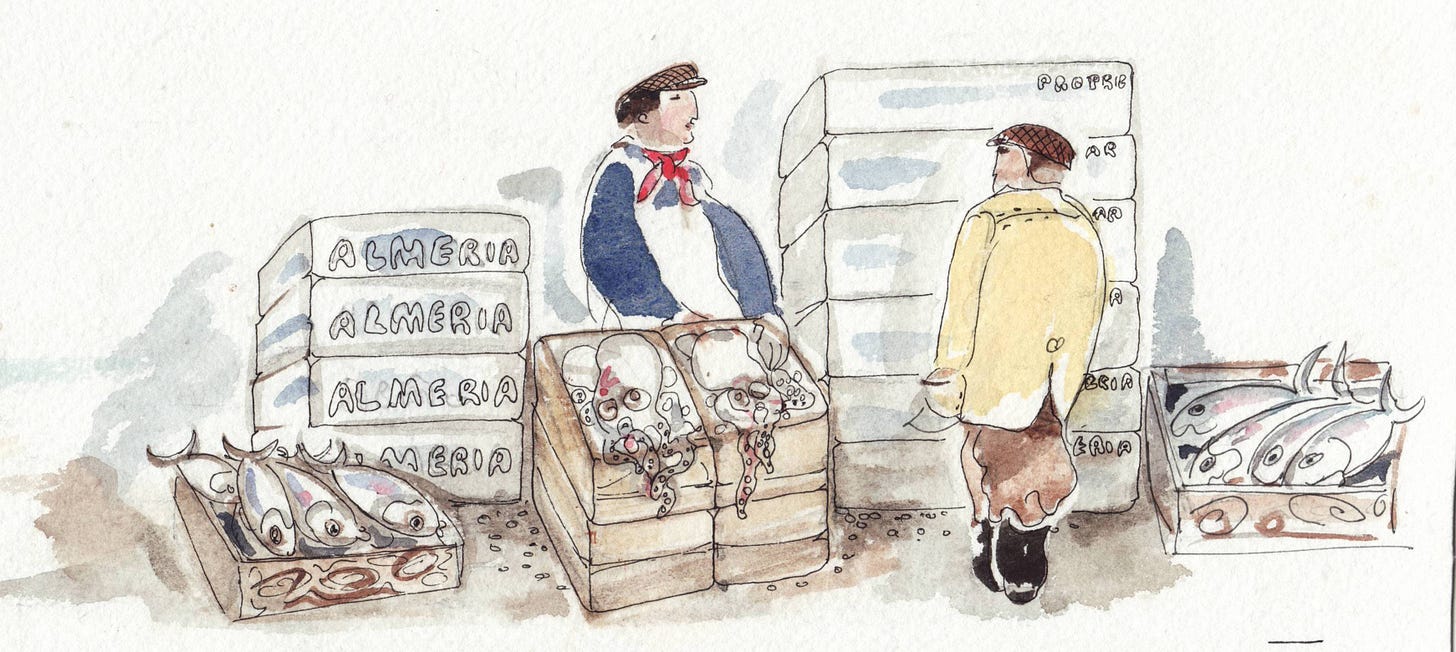Blame it on global warming - or maybe the traditional influx into West London of people who can really cook and don’t mind sorting out the catch from scratch - but the net result of the situation is that every Saturday morning in Notting Hill Farmers’ Market (my local), the fish-van arrives from the coast of Dorset (sometimes Kent or Sussex, following the shoals) to unload dripping crates of all those good things available round the coast of Britain: live crab (including spiders), lobster, sole, plaice, dab, turbot (rare), oysters, welks, clams, scallops and (with a bit of luck and a calm sea) cuttlefish, squid and the occasional octopus.
Happiness! But you do have to get there good and early for the full joy of a well-stocked slab. Squid and cuttlefish caught in British waters are of the mature well-travelled sort - some of them more than a metre long. The natives of these islands, traditionally (I choose my words with care), have a natural distrust of anything that’s not actually fish-shaped, particularly if its wobbly and has far too many arms, which had always meant that cephalopods (three of ‘em - squid, cuttlefish, octopus) were exported - sent away for ready money - to the markets of the Mediterranean.
Right. Anatomical differences tell you what you’re looking at on the slab when your cephalopod is fresh from the briny. Two of ‘em - squid (calamar sounds so much more appetising) and cuttlefish (cuttle: bone) - keep their bodies tucked away inside protective caps. Squid is long and pointed with a transparent supportive bone that looks like cleara plastic. Cuttlefish’ cuttles are oval (roundish) and made of solid white stuff that crumbles easily and is/was much appreciated by canaries for beak-sharpening. Both of the two cap-equipped cephalopods have soft bodies tucked inside the caps from which protrude large bright eyes and semi-transparent bodies with eight legs/arms and two tentacles (basically, feelers).
Octopuses (eight-footed, obviously), lack tentacles but are provided with eight legs/arms - two for walking and six for grabbing - and keep their soft bodies safely tucked inside a floppy hood without a supporting bone. Immature (young) octopus can be cooked as the other two (battered and fried, or stewed). Full-grown octopus (medium-sized weighs about a kilo) needs preliminary preparation before its ready for grilling or stewing: rinse thoroughly in salted water and pack into a roomy pot with enough well-salted water to cover generously; heat gently till everything turns opaque, and simmer for 20-30 minutes, keeping the water just trembling (don’t let it boil). Divide into legs and body in any way that works (discard the eye-part and sharp beak and scrape off the hard toenails). Now you’re ready to prepare as above. Or leave to gently overnight in a closed pot in its own juices (no need for exra liquid). This may well be too much information for the squeamish, but it seems to me we need to know these things, just in case.
When choosing any of the cephalopods, look for large bright eyes and a fine veil - thin outer skin - that varies from a delicate violet to chesnut brown and can be changed by the owner at will to suit the environment: scrape it off or not, as you please. To prepare squid or cuttlefish for the pot, push your hand inside the cap and detach the body and tentacles. Discard the bone or cuttle, cut off and discard the soft upper part of the body with the eyes and hard little beak. Save the little silvery ink-sack to add to cooking-juices, or to colour and flavour a risotto (you can freeze the ink-sac for later, or buy it sous-vide in a little packet from your friendly fishmonger). If necessary, scrape off the little toe-nails that rim the suckers on the tentacles (judge how hard they are with your fingers). Everything else is edible.
Sepia en su tinta
Cuttlefish cooked with its own ink, a Basque speciality but popular throught Spain, produces a deep soot-black sauce with a delicate, floral flavour (violets, perhaps) which makes collecting the little ink-sacs well worth the trouble. You can freeze the fresh ink for later, or buy it sous-vide (close to indefinite shelf-life) from your friendly fishmonger if you’re buying ready-prepared.
Serves 4
About 1k medium-sized fresh whole cuttlefish, un-prepared
4-5 tablespoons olive oil
1 large or 2 medium onions (lots), sliced into half-moons
2-3 garlic cloves, skinned and crushed
About 500g ripe tomatoes, scalded and skinned
1 heaped tablespoon fresh breadcrumbs
Salt and pepper
Rinse the cuttlefish thoroughly aa they’re sandy creatures. Remove the cuttle (or bon, and pull the tentacles and innards away from the body. Pull off and reserve the wings on outside of the cap.
Look out for the silvery ink sacks among the innards, and break the sacks into a small sieve placed over a bowl, reserving the inky liquid. It doesn't matter if you can't find all the sacks - 1 or 2 is quite enough to turn the sauce thick and sooty.
Remove and discard the beaks, eyes and the soft innards from the upper part of the body. Dice the tentacles and the lower body and wings, and tuck everything inside the caps.
Heat the oil in a roomy pan. Add the onions and garlic and fry gently until they soften - don’t let them brown. Add the tomatoes (chopped if large), bubble up, turn down the heat and simmer for 5-10 minutes to thicken the sauce (it depends on the juiciness of the tomatoes). Add the stuffed caps, making sure they’re perfectly submerged in the sauce (you may need to add a splash of water). Bubble up again, turn down the heat, lid loosely and leave to simmer gently until the caps are perfectly tender – 20-25 minutes. Add a little more water if necessay so the juices don’t dry out.
Meanwhile, mash the reserved ink with the breadcrumbs and parsley. Remove and reserve the caps, and stir the ink-mixture into the juices. Reheat gently without allowing the sauce to boil or the ink will go grainy. Taste and season. Return the caps to the sauce (don’t reboil). That’s all. Provide plenty of roughly-chunked bread for mopping; or serve with rice; or heap, as they like it in Andalucia, on a pile of twice-cooked chips.
p.s. Beloved paid subscripers will shortly be in receipt of recipes for grilled octopus with pimenton, and calamares (squid doesn’t really do ‘em justice) with white beans and chorizo.
p.p.s. More Spanish cooking with my watercolours in The Flavours of Andalucia (Gub Street, bless them). And there’s a neat little new edition of Classic Spanish just published by Hamlyn in their anniversary Classic series.













Share this post